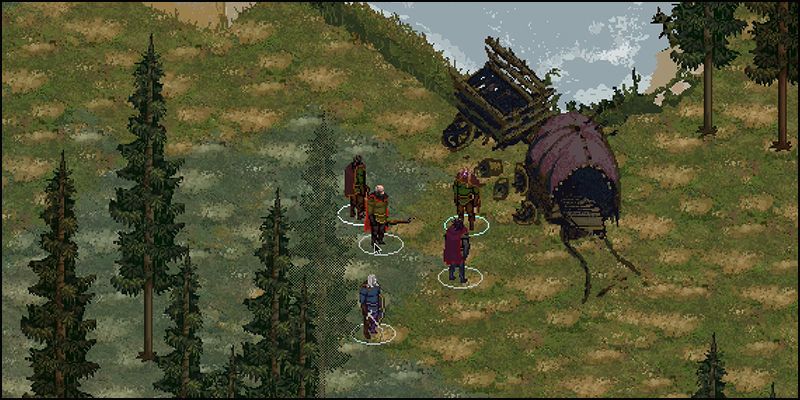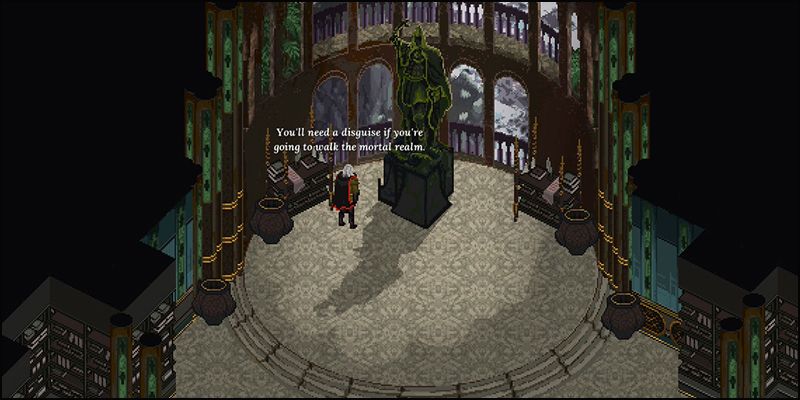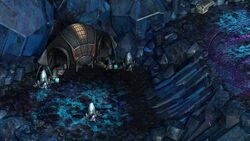RPG Codex Interview: Serpent in the Staglands (Now on Kickstarter)
RPG Codex Interview: Serpent in the Staglands (Now on Kickstarter)
Codex Interview - posted by Zed on Mon 31 March 2014, 05:54:44
Tags: Serpent in the Staglands; Whalenought StudiosWhalenought Studios, consisting of husband Joe (lead art) and wife Hannah (lead development), recently launched a Kickstarter for their pixelicious RTwP CRPG Serpent in the Staglands. "We ought to ask them some questions about their game", I thought, and they must have thought "RPG Codex is totally cool and Zed is awesome, wow", so here we are with an interview.
 [Interview by Zed, with contributions from Crooked Bee, Darth Roxor and felipepepe]
[Interview by Zed, with contributions from Crooked Bee, Darth Roxor and felipepepe]
RPG CODEX: You are no strangers to indie games development, but Serpent in the Staglands marks your first foray into PC RPGs. What made you want to create this game, and at this time?
Graphically, I would have a hard time trying to imagine a game looking more like a cross between Darklands and Baldur's Gate than Serpent in the Staglands. However, you cite these games as influences for the game's innards rather than how it looks. Let's start with Darklands. What have you drawn from this game?

There are a couple of obvious similarities to Baldur's Gate: the party control (even the selection circles seem to be similarly color-coded) and the real-time with pause combat system. Is there anything else that Baldur's Gate, or any other Infinity Engine game for that matter, has given inspiration for in Serpents in the Staglands?
On the Kickstarter page, you mention a few locations such as Emerald Mines and the forest domain of the Wandering Lady. Will the player travel seamlessly between these areas or do you use a world map system like the one found in the Infinity Engine games? Is the progression linear or can the player choose which areas to visit and in what order?
What are your primary inspirations for the world design and the lore behind the Staglands peninsula?

Serpent in the Staglands has the player control the mortal avatar of a moon lord (a god, as I understand it) called Necholai. What does this entail for the main character? Are you bound to any limitations such as only playing as a male character?
How will the player's party be established? The player obviously starts with the main character. Are followers later recruited as predefined characters at certain points in the story (as in Baldur's Gate), or can they be created at the start of the game as well (as in Darklands)? Also, what party size are you aiming for?
We know that players will choose up to three skills to be equipped by each party member, and those are changeable at any time during battle. Does this mean that the player will have no direct control over when and where abilities and spells are used?

According to the Kickstarter description, combat in Serpent in the Staglands is frenetic and dice roll-based, so that "the range of dice roll outcomes grows larger and more unpredictable" as you progress in skills and power. Could you elaborate on or provide some examples of how that is going to work? Further, apart from the swift pace and unpredictability, where will the challenge in combat come from?
You mention Aptitudes, a system to branch your main character's knowledge and persona, affecting conversations and interactions with the environment. Does this mean there will be alternate paths and solutions in the game, such as talking your way out of a situation rather than fighting? Perhaps through Darklands-style “choose-your-own-adventure” events?

Where do you see Whalenought heading with Serpent in the Staglands? It's a certainly a departure from your earlier, perhaps more accessible, mobile games. Are you looking to become the next Spiderweb Software or Basilisk Games, focusing on throwback CRPGs?
A few recent CRPGs such as Wasteland 2, Dead State and UnderRail (and a gazillion other games) have Early Access versions for sale on Steam. In the Kickstarter, you mention your goal to release the game in Winter 2014, while also adding that you have no intentions of releasing anything but a finished and polished product. It sounds like you could be among the developers who are skeptical towards Early Access? What are your thoughts on this trend?
Many thanks to Whalenought Studios for answering our questions. The Kickstarter for Serpent in the Staglands is at the time of publishing this interview still ongoing.

RPG CODEX: You are no strangers to indie games development, but Serpent in the Staglands marks your first foray into PC RPGs. What made you want to create this game, and at this time?
WHALENOUGHT: As huge crpg fans, this game is one we both have dreamed and started planning since the start of our studio. We both know our strengths lie in fantasy, adventure, and enticing narratives, and we’re confident that we’ll do the Staglands and the genre justice.
Graphically, I would have a hard time trying to imagine a game looking more like a cross between Darklands and Baldur's Gate than Serpent in the Staglands. However, you cite these games as influences for the game's innards rather than how it looks. Let's start with Darklands. What have you drawn from this game?
Thank you! That was absolutely what we were going for (and budgeted for). We’re keeping the art gritty and ground in some amount of realism.
Similar to their classless skill system, our system involves building your character by selecting any combat, spell or aptitude skills you’d like. This allows for a vast amount of customization and personality — rewarding creativity with your own custom build types. The Darklands combat is frenetic and pretty ruthless and we’re trying to capture that as well. Nothing was more satisfyingly demoralizing than failing to best some bandits and getting told they stole all your equipment and money and left you for dead. Their story scenes were the original inspiration for our Aptitude creation and uses outside combat.
Similar to their classless skill system, our system involves building your character by selecting any combat, spell or aptitude skills you’d like. This allows for a vast amount of customization and personality — rewarding creativity with your own custom build types. The Darklands combat is frenetic and pretty ruthless and we’re trying to capture that as well. Nothing was more satisfyingly demoralizing than failing to best some bandits and getting told they stole all your equipment and money and left you for dead. Their story scenes were the original inspiration for our Aptitude creation and uses outside combat.

There are a couple of obvious similarities to Baldur's Gate: the party control (even the selection circles seem to be similarly color-coded) and the real-time with pause combat system. Is there anything else that Baldur's Gate, or any other Infinity Engine game for that matter, has given inspiration for in Serpents in the Staglands?
Serpent in the Staglands definitely pays homage to the infinity engine games — the joy of party-based combat, adventuring and quests, and strategic (often stressful) battles are primary inspirations that helped form our game design decisions. A lot of people asked why we didn’t go with turn based, but from the beginning we thought the game would be stronger with real-time, intense, party based battles that few other games outside the infinity engine genre provided.
The RTS tactical control was one of the first things we set up to help get a feel of the game. Those circles are a WIP that just seemed like an obvious choice to put in during development, but they’ve worked so far!
The RTS tactical control was one of the first things we set up to help get a feel of the game. Those circles are a WIP that just seemed like an obvious choice to put in during development, but they’ve worked so far!
On the Kickstarter page, you mention a few locations such as Emerald Mines and the forest domain of the Wandering Lady. Will the player travel seamlessly between these areas or do you use a world map system like the one found in the Infinity Engine games? Is the progression linear or can the player choose which areas to visit and in what order?
We designed a system that’s completely open for the player to explore at will. Enemies and conflicts don’t level with you, so there isn’t necessarily an order, but general areas are safer out of the gate than others.
Similar to other crpgs, maps are individual scenes that you can exit near the edges that will bring you to an overworld map with markers that you manually traverse. You can have random events and ambushes take place while traveling, along with uncovering secret locations.
Similar to other crpgs, maps are individual scenes that you can exit near the edges that will bring you to an overworld map with markers that you manually traverse. You can have random events and ambushes take place while traveling, along with uncovering secret locations.
What are your primary inspirations for the world design and the lore behind the Staglands peninsula?
The lore itself is all original, no specific inspirations besides what naturally came in our subconscious from years of consuming fantasy literature. We wanted unique races we hadn’t seen before, but the world to be relatable. The look and feel of the world are meant to be Romanian / Transylvanian.

Serpent in the Staglands has the player control the mortal avatar of a moon lord (a god, as I understand it) called Necholai. What does this entail for the main character? Are you bound to any limitations such as only playing as a male character?
Not at all - Necholai, and all the gods in our lore, don’t necessarily have genders or races until they choose an avatar to roam around as. When Necholai assumes a mortal form you’re taken to an arbitration scene and can choose a name, gender and race, and from there his or her personality becomes whatever you want to make of it. Because Necholai has made a habit of keeping his distance from the mortal realm, it isn’t coming into the Staglands with a pre-determined personality or preferences, which means you will be exploring the world as him for the first time.
How will the player's party be established? The player obviously starts with the main character. Are followers later recruited as predefined characters at certain points in the story (as in Baldur's Gate), or can they be created at the start of the game as well (as in Darklands)? Also, what party size are you aiming for?
Your adventuring party of five can be collected throughout the game. There is a stretch goal up that will give us some resources to help develop rolling all the characters at the start of the game. In our current scope, other PCs are prebuilt with skill sets and personalities and some with side quests, and there will be several to choose from that you meet throughout the game. Some of our party-npcs do have a story or require your aid first to follow you, some you take away from their lives unwillingly to help you, some worship you, and any you find can be simply expendable meat shields if you choose. And then there are those that are more of a challenge to contain. I won't divulge anything to spoil that fun, but being the mortal avatar of a god has its perks, and downfalls as you'll find out.
We know that players will choose up to three skills to be equipped by each party member, and those are changeable at any time during battle. Does this mean that the player will have no direct control over when and where abilities and spells are used?
The three equipped skills are only combat skills, spells must be manually cast and targeted from your quick spells book. We’re really excited about the combat system. Unlike a typical crpg, we wanted warriors to have skills that are just as exciting as wizards, so we’ve created a wide array of skills and triggers for fighters that allow for creative and varied builds. Triggers for combat skills include on hit, on every attack, on every X attacks, on low health, on kill and at the start of a battle.

According to the Kickstarter description, combat in Serpent in the Staglands is frenetic and dice roll-based, so that "the range of dice roll outcomes grows larger and more unpredictable" as you progress in skills and power. Could you elaborate on or provide some examples of how that is going to work? Further, apart from the swift pace and unpredictability, where will the challenge in combat come from?
To elaborate on the dice roll outcomes, as you grow higher in level, your dice rolls have a larger range. For example, at level one, you could be rolling a 1d4 for your attack damage, and at level ten, due to skill upgrades, better equipment and buffs, you could be rolling a 1d24. Your characters aren’t reaching heroic levels of strength and intelligence, so much as increasing their odds of surviving against more and more challenging foes. We are trying to avoid the idea that your players become hyper-powerful, and are aware that death is always around the corner, even if you’re level 20 and facing a pack of wolves.
The challenge comes from the chaotic nature of combat and the variation in enemies strengths and abilities, and how you choose to use your skills. Every humanoid can have the same spells and skills as you do, and no two groups of enemies can necessarily be defeated with the same battle strategy. We want to keep the player on their toes and reward creative strategy and their skill usage.
Also to keep combat challenging, we’ve set up the monsters in the game to act like mini-boss battles, requiring unique ways to dispatch them. Spirits must have special dispatching spells cast upon them or they will return, and some have large area affecting spells or minions.
The challenge comes from the chaotic nature of combat and the variation in enemies strengths and abilities, and how you choose to use your skills. Every humanoid can have the same spells and skills as you do, and no two groups of enemies can necessarily be defeated with the same battle strategy. We want to keep the player on their toes and reward creative strategy and their skill usage.
Also to keep combat challenging, we’ve set up the monsters in the game to act like mini-boss battles, requiring unique ways to dispatch them. Spirits must have special dispatching spells cast upon them or they will return, and some have large area affecting spells or minions.
You mention Aptitudes, a system to branch your main character's knowledge and persona, affecting conversations and interactions with the environment. Does this mean there will be alternate paths and solutions in the game, such as talking your way out of a situation rather than fighting? Perhaps through Darklands-style “choose-your-own-adventure” events?
Yes, that’s exactly right! We don’t have the full screen story images in our budget like in Darklands, but all the events take place in real time in the world instead, either through dialogue or environmental interactions.

Where do you see Whalenought heading with Serpent in the Staglands? It's a certainly a departure from your earlier, perhaps more accessible, mobile games. Are you looking to become the next Spiderweb Software or Basilisk Games, focusing on throwback CRPGs?
Our plan is to continue to explore the world of Vol (where the Staglands lies) in future games. We have a lot planned for other continents to explore and are excited to continue unraveling the lore in other campaigns.
A few recent CRPGs such as Wasteland 2, Dead State and UnderRail (and a gazillion other games) have Early Access versions for sale on Steam. In the Kickstarter, you mention your goal to release the game in Winter 2014, while also adding that you have no intentions of releasing anything but a finished and polished product. It sounds like you could be among the developers who are skeptical towards Early Access? What are your thoughts on this trend?
For Serpent in the Staglands, we’re going with a closed beta from our Kickstarter community. We want to reward them for supporting us early and are excited to have a group of people who are already enthusiastic about offering critique and suggestions.
We’re aiming firstly to get on GoG, both because we love their site and to support the DRM-free distribution of games. We’ll be using Greenlight thereafter to also try to get on Steam! We think early access can certainly be beneficial for some developers, but believe our narrative-driven game is best experienced in its finished form for players to engross themselves in, so we will be sticking with closed beta testing. We’ll definitely be sharing updates throughout the rest of the development process though!
We’re aiming firstly to get on GoG, both because we love their site and to support the DRM-free distribution of games. We’ll be using Greenlight thereafter to also try to get on Steam! We think early access can certainly be beneficial for some developers, but believe our narrative-driven game is best experienced in its finished form for players to engross themselves in, so we will be sticking with closed beta testing. We’ll definitely be sharing updates throughout the rest of the development process though!
Many thanks to Whalenought Studios for answering our questions. The Kickstarter for Serpent in the Staglands is at the time of publishing this interview still ongoing.
There are 130 comments on RPG Codex Interview: Serpent in the Staglands (Now on Kickstarter)













